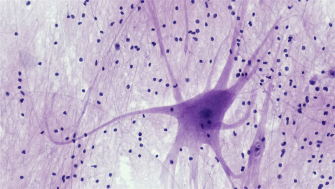Lurbinectedin for Ewing sarcoma and neuroendocrine tumors: Are we there yet?
Last updated: 14 May 2024

You can legally access new medicines, even if they are not approved in your country.
Learn howZepzelca (lurbinectedin) got its first global approval in 2020, for the treatment of small cell lung cancer (SCLC). Since then, lurbinectedin has been included in multiple clinical trials investigating its potential role in also treating FET-fused tumors, soft tissue sarcoma, and several solid tumors.
Other potential treatment applications for lurbinectedin are in the treatment of neuroendocrine tumors and Ewing sarcoma. The potential use of lurbinectedin for these rare types of cancer is of interest, as there is currently no specific treatment available.
Can lurbinectedin be used to treat Ewing sarcoma and neuroendocrine tumors? Let's have a look at the latest clinical trial data and approval timelines, so that you know what this medicine could mean for you or loved ones.
What is lurbinectedin approved for?
Zepzelca (lurbinectedin) is currently approved by the FDA for the treatment of metastatic small-cell lung cancer (SCLC). It is indicated specifically for patients with disease progression following first-line chemotherapy.
Lurbinectedin's accelerated FDA approval was based on the results of a Phase II clinical trial. In the trial, the medicine demonstrated a durable response rate in patients with SCLC. To maintain this approval, further clinical trials need to confirm the efficacy and safety of lurbinectedin. As of May 2024, lurbinectedin is not approved for use in any other cancer type or as a first-line treatment for SCLC.
What are neuroendocrine tumors?
Neuroendocrine tumors (NETs) are rare and arise from neuroendocrine cells, which are found throughout the body. Primarily, NETs occur in the gastrointestinal tract, lungs, pancreas, and thyroid.
Neuroendocrine cells have both nerve cell (neuro) and hormone-producing (endocrine) characteristics. Some neuroendocrine tumors produce excess hormones (functional neuroendocrine tumors). Others don't release hormones or don't release enough to cause symptoms (nonfunctional neuroendocrine tumors) 2.
NETs can be difficult to diagnose and treat. Often, patients have hormonal symptoms for many years before finally getting a diagnosis. And once they do, there are multiple treatment pathways, but no treatment that is specifically designed for NETs.
Why is lurbinectedin relevant for neuroendocrine tumors?
The only currently approved indication for lurbinectedin is small-cell lung cancer (SCLC). Although SCLC is not considered a type of neuroendocrine tumor in the traditional sense, it does involve neuroendocrine cells and behaves similarly to NETs 1.
Because of lurbinectedin's results in treating SCLC, researchers have shown interest in testing its efficacy and safety in other, more typical, neuroendocrine tumors.
Given the limited treatment options available for NETs, lurbinectedin could be a valuable addition to the therapeutic arsenal for patients with this challenging disease. Its ability to target the DNA transcription process of cancer cells could offer a novel approach to combating tumor growth, potentially improving outcomes for patients with neuroendocrine tumors.
Why is lurbinectedin relevant for Ewing sarcoma?
Ewing sarcoma is a rare type of bone or soft tissue cancer that primarily affects children and young adults. Ewing sarcoma is not classified as a neuroendocrine tumor. However, there are certain characteristics and features of the condition that are associated with neuroendocrine properties.
For example, both Ewing sarcoma and some neuroendocrine tumors can be associated with specific genetic abnormalities. Ewing sarcoma is characterized by the presence of chromosomal translocations involving the EWSR1 gene and members of the ETS family of transcription factors. This leads to the formation of fusion proteins such as EWS-FLI1. Similarly, certain neuroendocrine tumors may harbor specific genetic mutations or chromosomal alterations that contribute to their development.
Ewing sarcoma's reliance on EWS-FLI1 is particularly interesting to researchers. Since lurbinectedin interrupts DNA transcription processes in tumor cells, it could potentially disrupt the formation of EWS-FLI1 in Ewing sarcoma as well. That's why clinical trials to test that possibility have been ongoing for several years.
How effective is lurbinectedin for neuroendocrine tumors and Ewing sarcoma?
Some clinical studies involving lurbinectedin in the treatment of NETs and Ewing sarcoma have been completed in recent years. Several are still ongoing. This is what you should know about the data available so far.
Lurbinectedin for pre-treated neuroendocrine tumors
In 2022, the results of a Phase 2 trial with lurbinectedin on 31 patients with pre-treated NETs were published 3. These are the highlights:
- The objective response rate was 6.5%;
- The median duration of response was 4.7 months;
- The median progression-free survival was 1.4 months;
- The median overall survival was 7.4 months 3.
Overall, the researchers found an acceptable and manageable safety profile of lurbinectedin. Considering the antitumor activity that was reported in the study, they considered further investigations with a more selected population of NET patients to be justified.
Lurbinectedin for relapsed Ewing sarcoma
A 2022 phase 2 trial focused on lurbinectedin as a treatment for patients with Ewing sarcoma, who had received at least 2 prior rounds of chemotherapy 4. Here are the main reported results:
- The objective response rate was 14.3%;
- The median duration of response was 4.2 months;
- The median progression-free survival was 2.7 months;
- The median overall survival was 12 months 4.
According to the researchers, the trial results are an indication that "lurbinectedin could represent a valuable addition to therapies currently used in the management of [Ewing sarcoma]" 4.
To further explore Zepzelca's potential in treating Ewing sarcoma, a clinical trial involving children and young adults is currently ongoing 5. The study is expected to be completed in June 2027.
When will lurbinectedin be approved for Ewing sarcoma and neuroendocrine tumors?
It's difficult to say at the moment. Despite the encouraging initial results shared above, more clinical trial data is needed before lurbinectedin can be considered for marketing authorization to treat Ewing sarcoma or neuroendocrine tumors.
With multiple clinical trials currently ongoing, we can only hope that their results will demonstrate the efficacy and safety of Zepzelca for these challenging indications. Until the study results are available, though, all we can do is wait.
Can my doctor prescribe Zepzelca for Ewing sarcoma?
Technically, they can. However, it's unlikely.
Lurbinectedin has not yet been approved anywhere for the treatment of Ewing sarcoma or neuroendocrine tumors. And while your doctor has the authority to prescribe it to you for these indications anyway (known as off-label prescription), they probably won't. The clinical trials involving lurbinectedin in neuroendocrine tumor treatment are not yet convincing enough for that.
However, as more clinical trial data becomes available, your doctor may decide to prescribe Zepzelca off-label, or even before it's approved in your country for any indication at all. If that's the case and you're wondering how to access a medicine before it's available locally, our team at Everyone.org can help you import the medicine for your personal use. Simply get in touch and send us your prescription to get started.
References:
- Cattamanchi, Adithya. Is Small-Cell Lung Cancer a Neuroendocrine Tumor? Healthline, 15 July 2022.
- Neuroendocrine tumors - Symptoms and causes. Mayo Clinic, 23 June 2023.
- Lurbinectedin in patients with pretreated neuroendocrine tumours: Results from a phase II basket study. European Journal of Cancer, Accessed 14 May 2024.
- Antitumor Activity of Lurbinectedin, a Selective Inhibitor of Oncogene Transcription, in Patients with Relapsed Ewing Sarcoma: Results of a Basket Phase II Study. PubMed, Accessed 14 May 2024.
- JZP712-101: Study of Lurbinectedin Monotherapy in Pediatric and Young Adult Participants With Relapsed/Refractory Ewing Sarcoma (EMERGE 101). Cincinnati Children's Hospital. Accessed 14 May 2024.




